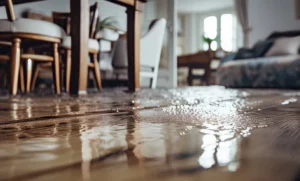Water damage can cause serious issues with carpets, leading homeowners to face a difficult decision: whether to remove or replace the affected carpet. This choice requires careful consideration, as several factors come into play. Homeowners will have a number of crucial options to consider that will guide you in making an informed decision regarding water damaged carpets. By understanding the extent of the damage, health implications, restoration possibilities, and cost factors, homeowners can determine the most appropriate course of action.
Extent of the Damage
Assessing the extent of water damage is vital when deciding the fate of a carpet. If the damage is limited to a small area or a specific spot, such as a spill or a minor leak, prompt professional cleaning and drying may salvage the carpet. On the other hand, extensive flooding or prolonged exposure to moisture can result in severe damage that is difficult to reverse.
Carpets that have been saturated for an extended period are more prone to mold and mildew growth, which poses health risks and compromises indoor air quality. Additionally, water damage may weaken the carpet fibers, causing them to become brittle, discolored, or deformed. It’s crucial to assess the extent and severity of the damage before making a decision.
Health Considerations
Water damaged carpets can become breeding grounds for mold, bacteria, and other pathogens, posing potential health risks. If the water damage is due to unsanitary sources, such as sewage backup or contaminated floodwater, it is strongly recommended to remove and replace the carpet. Even in cases of clean water damage, there is still a risk of mold growth if the carpet remains wet for an extended period.
Mold spores can trigger allergies, respiratory issues, and other health problems, particularly for individuals with compromised immune systems or pre-existing respiratory conditions. Consider the health implications for your household members, especially those who may be more susceptible to mold-related health issues.
Restoration Possibilities
In some instances, professional restoration services may be able to salvage water damaged carpets, depending on the severity of the damage and the type of carpet. Restoration techniques such as water extraction, drying, and specialized treatments can mitigate the damage and restore the carpet’s condition.
However, there are limitations to restoration. If the carpet padding is extensively damaged or if the carpet has been submerged in contaminated water, restoration may not be feasible. Additionally, older carpets or those with pre-existing wear and tear may not respond well to restoration efforts. Consider consulting with a professional water damage restoration specialist to assess the restoration possibilities for your specific carpet.
Cost Factors
The cost is an important consideration when deciding whether to remove or replace water damaged carpets. Restoration services can be costly, particularly for severe damage that requires extensive cleaning and drying. Additionally, if the carpet cannot be effectively restored, the cost of replacement should be factored into the decision-making process.
It’s worth noting that insurance coverage may play a role in covering the costs associated with water damage. Review your insurance policy to understand the extent of coverage for water damage and consult with your insurance provider to determine the best course of action.
Deciding whether to remove or replace water damaged carpets requires careful evaluation of various factors. Assessing the extent of the damage, considering the health implications, exploring restoration possibilities, and factoring in the costs are essential considerations. While professional restoration services may salvage some carpets, severe damage or unsanitary water sources often necessitate complete removal and replacement. It is crucial to prioritize the health and well-being of your household members and consult with experts to make an informed decision.






